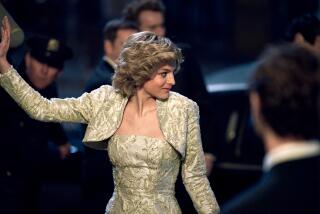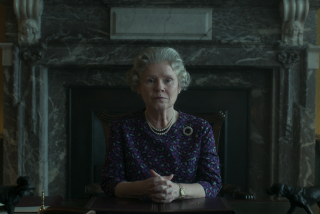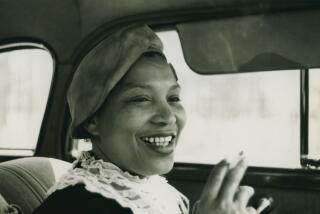A queen who shaped era and image
The titian-haired queen could work a room better than Bill Clinton. In truth, she could work an entire country.
The day before Elizabeth I’s coronation in 1558, she rode among her people on her way to Westminster Abbey. Five years earlier, her half-sister “Bloody Mary” had been crowned; that fierce Catholic princess sat like a stone in her coach, her eyes fixed straight ahead. But Elizabeth, the great Protestant hope of a nation bleeding from religious strife, chose to share her obvious pleasure with the crowd. She carried a sprig of rosemary given to her by a poor, elderly woman. And when a young boy handed her an English Bible -- the Bible that Protestant martyrs had died for during Mary’s brief but brutal Catholic regime -- Elizabeth made sure that the people out of earshot, in the back of the throng, understood her delight. She took the Bible in her hands, kissed it, held it high above her for everyone to see, then clasped it to her heart.
It was a potent piece of nation-building theater.
Not long afterward, the subjects of the new queen could buy an inexpensive account of the procession in book form. A copy of that 16th century bestseller is among the dozens of eloquent objects by and about Elizabeth I in an exhibition at the Huntington Library, Art Collections and Botanical Gardens in San Marino, through June 15.
Titled “Gloriana! The Golden Legend of Elizabeth I,” the show marks the 400th anniversary of Good Queen Bess’ death on March 24, 1603. Gloriana was the name that poet Edmund Spenser gave his Elizabeth-like Faerie Queen -- a 1590 first edition of his epic poem is in the show.
The show abounds with treasures that speak of Elizabeth and her Age -- a letter putting off a suitor, signed with her distinctive flourish, and another on that troublesome Mary, Queen of Scots; a Nicholas Hilliard miniature portrait; Richard Hakluyt’s account of Sir Francis Drake’s circumnavigation of the globe, which Elizabeth blessed and helped finance; and the first printed edition of Shakespeare’s “The Merry Wives of Windsor,” said to have been commissioned by the queen, who called for a play about Falstaff in love.
Remarkably, the show is drawn entirely from the Huntington’s own collection of Renaissance materials, most of it amassed during the lifetime of founder Henry Huntington. The library’s rare books, manuscripts and other special collections attract more scholars in the humanities to the Huntington than any other research institution in the U.S., except the Library of Congress -- 1,800 annually, according to Mary L. Robertson, its William A. Moffett chief curator of manuscripts.
Robertson, who did her doctoral dissertation at UCLA in Tudor history, is the curator of “Gloriana.” For all the research that has been done on Elizabeth I, for all the continuing popular fascination, Robertson realized that many people don’t know that Elizabeth I was one of history’s great spinmeisters. “She is a genius at public relations,” says Robertson, who often speaks of Elizabeth as if she were about to appear in the doorway, in farthingale and ropes of pearls. “She understands the value of crafting and propagating an image.” And the image that she created is the one that persists today, one of a handful of instantly identifiable historical faces. Robertson recalls that she was organizing the show in the months leading up to the 2000 presidential election, when Americans were preoccupied with leadership and hyper-aware of how presentation of self can boost, or destroy, a person who hopes to lead. Elizabeth was, Robertson explains, a great conciliator, determined to bring peace to her torn nation. She wanted a Protestant England, but not at the cost of more lives. And so she did something that we think of as both admirable and terribly modern -- she adopted a policy of moderation and tolerance. She expected, indeed she commanded, her subjects to conform publicly to the strictures of the Church of England, but she didn’t scrutinize too closely the beliefs they held in their hearts.
“Her line was that she didn’t want to make windows into men’s souls,” Robertson says.
The printing press was transforming Elizabeth’s Europe, and she grasped how it could extend her reach and influence.
Like her father, Henry VIII, Robertson says, “she uses the new technology of cheap print.” She had her royal proclamations and other official statements printed and sent to every village, where they served, Robertson says, “not necessarily as propaganda, but as an opportunity to explain and justify.”
Robertson gives the example of Elizabeth’s response to the 1601 rebellion led by the Earl of Essex, once her favorite. Within 48 hours, literate people throughout England could read the queen’s announcement that a revolt had taken place, that it had been put down, and that her majesty was still in charge. For the queen’s subject reading such a broadside, Robertson says, “it’s as if the queen speaks directly to you.”
“It’s not quite television, but it reaches a much larger audience than would have been reached in the past by word of mouth.”
Her speeches were published and widely distributed as well.
“She is a brilliant wordsmith,” says Robertson. “Some of her phrases are almost Churchillian.” Like Henry’s other children, she had a fine humanist education. She read seven languages and could give off-the-cuff speeches in Latin. “She has grown up reading the great speeches of the world,” says Robertson, explaining that Elizabeth was steeped in classical rhetoric and knew its strategies and power. She could move an audience to tears -- she still can, 400 years later.
Among the speeches excerpted in the show is her famous address to her troops in 1588, before she knew that the Armada had been defeated. After saying she is ready to die in the dust with her men, she says: “I know I have the body of a weak and feeble woman, but I have the heart and stomach of a king, and of a king of England too, and think foul scorn that Parma or Spain, or any prince of Europe should dare to invade the borders of my realm....”
As modern as Elizabeth was, Robertson doesn’t buy the notion that she was a feminist in our sense of the term. “The political world in which she came to power simply did not believe a woman was capable of ruling,” the curator explains. “What she did believe was that there were some exceptional women, and she was one of them.”
*
‘Gloriana!’
What: “Gloriana! The Golden Legend of Elizabeth I”
Where: Huntington Library, Art Collections and Botanical Gardens, 1151 Oxford Road, San Marino
When: Noon-4:30 p.m, Tuesday-Friday; 10:30 a.m.-4:30 p.m., Saturday and Sunday. Closed Mondays and Christmas Eve, Christmas, New Year’s Day. Ends June 15.
Contact: (626) 405-2100
More to Read
The biggest entertainment stories
Get our big stories about Hollywood, film, television, music, arts, culture and more right in your inbox as soon as they publish.
You may occasionally receive promotional content from the Los Angeles Times.










